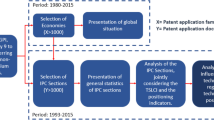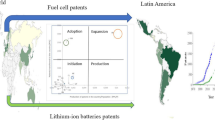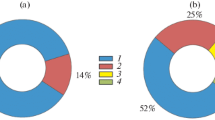Abstract
Advancing portable electronics and electric vehicles is heavily dependent on the cutting-edge lithium-ion (Li-ion) battery technology, which is closely linked to the properties of cathode materials. Identifying trends and prospects of cathode materials based on patent analysis is considered a kernel to optimize and refine battery related markets. In this paper, a patent analysis is performed on 6 popular cathode materials by comprehensively considering performance comparison, development trend, annual installed capacity, technology life cycle, and distribution among regions and patent assignees. In the technology life cycle, the cathode materials majorly used in electric vehicle have entered maturity stage, while the lithium cobalt oxide (LCO) cathode that is widely used in portable electronics is still in the growth stage. In global patent distributions, China holds more than 50% of total patents. In the top 10 patent assignees of 6 cathode materials, 2 institutes are from China with the rest being Japan (6) and Republic of Korea (2), indicating that the technology of cathode materials in China is relatively scattered while cathode research is highly concentrated in Japan and Republic of Korea. Moreover, the patent distribution has to consider practical issues as well as the impacts of core patents. For example, the high cost discourages the intention of applying international patents. This paper is expected to stimulate battery research, understand technical layout of various countries, and probably forecast innovative technology breakthroughs.

Similar content being viewed by others
References
Yang C. Running battery electric vehicles with extended range: Coupling cost and energy analysis. Applied Energy, 2022, 306: 118116
Li M, Lu J, Chen Z, et al. 30 years of lithium-ion batteries. Advanced Materials, 2018, 30(33): 1800561
Mennel J A, Chidambaram D. A review on the development of electrolytes for lithium-based batteries for low temperature applications. Frontiers in Energy, 2023, 17(1): 43–71
Schmuch R, Wagner R, Hörpel G, et al. Performance and cost of materials for lithium-based rechargeable automotive batteries. Nature Energy, 2018, 3(4): 267–278
Haji Akhoundzadeh M, Panchal S, Samadani E, et al. Investigation and simulation of electric train utilizing hydrogen fuel cell and lithium-ion battery. Sustainable Energy Technologies and Assessments, 2021, 46: 101234
Aguilar P, Groß B. Battery electric vehicles and fuel cell electric vehicles, an analysis of alternative powertrains as a mean to decarbonise the transport sector. Sustainable Energy Technologies and Assessments, 2022, 53: 102624
Cano Z P, Banham D, Ye S, et al. Batteries and fuel cells for emerging electric vehicle markets. Nature Energy, 2018, 3(4): 279–289
da Silva Lima L, Quartier M, Buchmayr A, et al. Life cycle assessment of lithium-ion batteries and vanadium redox flow batteries-based renewable energy storage systems. Sustainable Energy Technologies and Assessments, 2021, 46: 101286
Huang Y. The discovery of cathode materials for lithium-ion batteries from the view of interdisciplinarity. Interdisciplinary Materials, 2022, 1(3): 323–329
Whittingham M S. Chalcogenide battery. US Patent, 4009052, 1977-2-22
Monroe D. Building a better battery. MRS Bulletin, 2020, 45(3): 246–247
Mizushima K, Jones P C, Wiseman P J, et al. LixCoO2 (0 < x ⩽ 1): A new cathode material for batteries of high energy density. Materials Research Bulletin, 1980, 15(6): 783–789
Winter M, Barnett B, Xu K. Before Li ion batteries. Chemical Reviews, 2018, 118(23): 11433–11456
Liang Y, Zhao C Z, Yuan H, et al. A review of rechargeable batteries for portable electronic devices. InfoMat, 2019, 1(1): 6–32
Thackeray M M, David W I F, Bruce P G, et al. Lithium insertion into manganese spinels. Materials Research Bulletin, 1983, 18(4): 461–472
Thackeray M M, Lee E, Shi B, et al. Review—From LiMn2O4 to partially-disordered Li2MnNiO4: The evolution of lithiated-spinel cathodes for Li-ion batteries. Journal of the Electrochemical Society, 2022, 169(2): 020535
Iskandar Radzi Z, Helmy Arifin K, Zieauddin Kufian M, et al. Review of spinel LiMn2O4 cathode materials under high cut-off voltage in lithium-ion batteries: Challenges and strategies. Journal of Electroanalytical Chemistry, 2022, 920: 116623
Padhi A K, Nanjundaswamy K S, Goodenough J B. Phosphoolivines as positive-electrode materials for rechargeable lithium batteries. Journal of the Electrochemical Society, 1997, 144(4): 1188–1194
Tian J, **ong R, Shen W, et al. State-of-charge estimation of LiFePO4 batteries in electric vehicles: A deep-learning enabled approach. Applied Energy, 2021, 291: 116812
Yang X G, Liu T, Wang C Y. Thermally modulated lithium iron phosphate batteries for mass-market electric vehicles. Nature Energy, 2021, 6(2): 176–185
Matsubara Y, Ueda M, Inoue H, et al. Lithium-nickel-cobalt composite oxide for secondary batteries comprises composite oxide of lithium, nickel, cobalt and at least one from aluminium, iron, manganese and boron. Japan Patent, PCT/JP97/02803, 1998-2-19
Liu Z, Yu A, Lee J Y. Synthesis and characterization of LiNi1−x−y,CoxMnyO2 as the cathode materials of secondary lithium batteries. Journal of Power Sources, 1999, 81–82: 416–419
Whittingham M S. History, evolution, and future status of energy storage. Proceedings of the IEEE, 2012, 100(Special Centennial Issue): 1518–1534
Song L, Zheng Y, **ao Z, et al. Review on thermal runaway of lithium-ion batteries for electric vehicles. Journal of Electronic Materials, 2022, 51(1): 30–46
Feng X, Zheng S, He X, et al. Time sequence map for interpreting the thermal runaway mechanism of lithium-ion batteries with LiNixCoyMnzO2 cathode. Frontiers in Energy Research, 2018, 6: 126
Yan P, Zheng J, **ao J, et al. Recent advances on the understanding of structural and composition evolution of LMR cathodes for Li-ion batteries. Frontiers in Energy Research, 2015, 3: 26
Liu S, Wang B, Zhang X, et al. Reviving the lithium-manganese-based layered oxide cathodes for lithium-ion batteries. Matter, 2021, 4(5): 1511–1527
Mohanty D, Li J, Nagpure S C, et al. Understanding the structure and structural degradation mechanisms in high-voltage, lithium-manganese-rich lithium-ion battery cathode oxides: A review of materials diagnostics. MRS Energy & Sustainability, 2015, 2(1): 15
Sathiya M, Rousse G, Ramesha K, et al. Reversible anionic redox chemistry in high-capacity layered-oxide electrodes. Nature Materials, 2013, 12(9): 827–835
Abbas A, Zhang L, Khan S U. A literature review on the state-of-the-art in patent analysis. World Patent Information, 2014, 37: 3–13
Lee S, Yoon B, Lee C, et al. Business planning based on technological capabilities: Patent analysis for technology-driven roadmap**. Technological Forecasting and Social Change, 2009, 76(6): 769–786
Qu Z, Zhang S, Zhang C. Patent research in the field of library and information science: Less useful or difficult to explore? Scientometrics, 2017, 111(1): 205–217
Abraham B P, Moitra S D. Innovation assessment through patent analysis. Technovation, 2001, 21(4): 245–252
Evangelista A, Ardito L, Boccaccio A, et al. Unveiling the technological trends of augmented reality: A patent analysis. Computers in Industry, 2020, 118: 103221
** L, Sun X, Ren H, et al. Hotspots and trends of biological water treatment based on bibliometric review and patents analysis. Journal of Environmental Sciences, 2023, 125: 774–785
Ma S C, Xu J H, Fan Y. Characteristics and key trends of global electric vehicle technology development: A multi-method patent analysis. Journal of Cleaner Production, 2022, 338: 130502
Li D, Alkemade F, Frenken K, et al. Catching up in clean energy technologies: A patent analysis. Journal of Technology Transfer, 2023, 48(2): 693–715
Wang H, Sun B. Diffusion mechanism of leading technology in the New Energy industry based on the Bass Model. Frontiers in Energy Research, 2021, 9: 586787
Wagner R, Preschitschek N, Passerini S, et al. Current research trends and prospects among the various materials and designs used in lithium-based batteries. Journal of Applied Electrochemistry, 2013, 43(5): 481–496
Sick N, Krätzig O, Eshetu G G, et al. A review of the publication and patent landscape of anode materials for lithium-ion batteries. Journal of Energy Storage, 2021, 43: 103231
Ershadi M, Javanbakht M, Kiaei Z, et al. A patent landscape on Fe3O4/graphene-based nanocomposites in lithium-ion batteries. Journal of Energy Storage, 2022, 46: 103924
Aaldering L J, Leker J, Song C H. Analysis of technological knowledge stock and prediction of its future development potential: The case of lithium-ion batteries. Journal of Cleaner Production, 2019, 223: 301–311
Pu G, Zhu X, Dai J, et al. Understand technological innovation investment performance: Evolution of industry-university-research cooperation for technological innovation of lithium-ion storage battery in China. Journal of Energy Storage, 2022, 46: 103607
Mejia C, Kajikawa Y. Emerging topics in energy storage based on a large-scale analysis of academic articles and patents. Applied Energy, 2020, 263: 114625
Golembiewski B, vom Stein N, Sick N, et al. Identifying trends in battery technologies with regard to electric mobility: Evidence from patenting activities along and across the battery value chain. Journal of Cleaner Production, 2015, 87: 800–810
Feng S, Magee C L. Technological development of key domains in electric vehicles: Improvement rates, technology trajectories and key assignees. Applied Energy, 2020, 260: 114264
Altenburg T, Corrocher N, Malerba F. China’s leapfrogging in electromobility. A story of green transformation driving catch-up and competitive advantage. Technological Forecasting and Social Change, 2022, 183: 121914
Clarivate. Derwent World Patents Index (DWPI). 2023-1-31, available at website of Clarivate
Clarivate. Derwent Patents Citation Index. 2023-1-31, available at website of Clarivate
Chen X, Song W J, Niu Y T. New energy lithium battery series report. 2023-1-31, available at website of Dfcfw (in Chinese)
Qianzhan Website. Analysis of global lithium battery cathode material on market size and competition pattern in 2022. 2023-1-31, available at website of Qianzhan (in Chinese)
Celine B, Lukasz B, Samantha W. As lithium-ion battery materials evolve, suppliers face new challenges. 2023-1-31, available at website of Spglobal
Whittingham M S. Lithium batteries and cathode materials. Chemical Reviews, 2004, 104(10): 4271–4302
Zu C X, Li H. Thermodynamic analysis on energy densities of batteries. Energy & Environmental Science, 2011, 4(8): 2614–2624
Luo Y, Wei H, Tang L, et al. Nickel-rich and cobalt-free layered oxide cathode materials for lithium-ion batteries. Energy Storage Materials, 2022, 50: 274–307
Ding Y, Cano Z P, Yu A, et al. Automotive Li-ion batteries: Current status and future perspectives. Electrochemical Energy Reviews, 2019, 2(1): 1–28
Vaalma C, Buchholz D, Weil M, et al. A cost and resource analysis of sodium-ion batteries. Nature Reviews. Materials, 2018, 3(4): 18013
Wu X, Song K, Zhang X, et al. Safety issues in lithium-ion batteries: Materials and cell design. Frontiers in Energy Research, 2019, 7: 65
Su Y, Zhang Q, Chen L, et al. Stress accumulation in Ni-rich layered oxide cathodes: Origin, impact, and resolution. Journal of Energy Chemistry, 2022, 65: 236–253
Zhang H, Liu H, Piper L F J, et al. Oxygen loss in layered oxide cathodes for Li-ion batteries: Mechanisms, effects, and mitigation. Chemical Reviews, 2022, 122(6): 5641–5681
Su Y, Zhao J, Chen L, et al. Interfacial degradation and optimization of Li-rich cathode materials. Chinese Journal of Chemistry, 2021, 39(2): 402–420
Lyu Y, Wu X, Wang K, et al. An overview on the advances of LiCoO2 cathodes for lithium-ion batteries. Advanced Energy Materials, 2021, 11(2): 2000982
Global Market Insights. Lithium iron phosphate (LFP) battery market. 2023-6-6, available at website of Gminsights
Fastmarkets. NCM batteries expected to keep largest EV market share: Cobalt Congress 2023. 2023-6-6, available at website of Fastmarkets
Goodenough J B, Mizushima K, Wiseman P J, et al. Electrochemical cell and method of making ion conductors for said cell. US Patent, 0017400, 1980-10-15
Reddy M V, Mauger A, Julien C M, et al. Brief history of early lithium-battery development. Materials, 2020, 13(8): 1884
Blomgren G E. The development and future of lithium-ion batteries. Journal of the Electrochemical Society, 2017, 164(1): A5019–A5025
Chen S, **ong J, Qiu Y, et al. A bibliometric analysis of lithium-ion batteries in electric vehicles. Journal of Energy Storage, 2023, 63: 107109
Kong L, Tang C, Peng H J, et al. Advanced energy materials for flexible batteries in energy storage: A review. SmartMat, 2020, 1(1): 1007
Eftekhari A. Lithium batteries for electric vehicles: From economy to research strategy. ACS Sustainable Chemistry & Engineering, 2019, 7(6): 5602–5613
Pelegov D V, Pontes J. Main drivers of battery industry changes: Electric vehicles—A market overview. Batteries, 2018, 4(4): 65
Vernon R. International investment and international trade in the product cycle. Quarterly Journal of Economics, 1966, 80(2): 190–207
Haupt R, Kloyer M, Lange M. Patent indicators for the technology life cycle development. Research Policy, 2007, 36(3): 387–398
Lee M T, Su W N. Search for the develo** trends by patent analysis: A case study of lithium-ion battery electrolytes. Applied Sciences, 2020, 10(3): 952
Aaldering L J, Song C H. Tracing the technological development trajectory in post-lithium-ion battery technologies: A patent-based approach. Journal of Cleaner Production, 2019, 241: 118343
Malhotra A, Zhang H, Beuse M, et al. How do new use environments influence a technology’s knowledge trajectory? A patent citation network analysis of lithium-ion battery technology Research Policy, 2021, 50(9): 104318
Acknowledgements This work was supported by the Shaanxi Provincial Philosophy and Social Science Research Project (Grant No. 2023QN0169), the National and Regional Research projects of the Ministry of Education, China (Grant No. 2021-G37), and the 2023 **’an International Studies University Graduate Research Project.
Author information
Authors and Affiliations
Corresponding author
Ethics declarations
Competing interests The authors declare that they have no competing interests.
Rights and permissions
About this article
Cite this article
Yang, C., Mu, XY. Map** the trends and prospects of battery cathode materials based on patent landscape. Front. Energy 17, 822–832 (2023). https://doi.org/10.1007/s11708-023-0900-x
Received:
Accepted:
Published:
Issue Date:
DOI: https://doi.org/10.1007/s11708-023-0900-x




